
Centre of Jaina Studies Newsletter: SOAS - University of London
Jaina Narratives, the 13th Jaina Studies Workshop held at SOAS on the 17th and 18th of March 2011, was a successful Jaina literary marathon. Presenters approached the theme from a broad array of perspectives, ranging from the applicability of narratological tools, Jaina poetry, and the phenomenon of intertextuality in Jaina narratives, to modern day Jaina comic books. This rich variety of topics combined with the critical remarks by the discussants ensured that the audience gained many new insights into various aspects of Jaina narratives.
The 11th Annual Jaina Lecture was delivered by Robert Zydenbos of the University of Munich. Discussing the tale Bharatēśavaibhava, the literary masterpiece of the Jaina Karnāṭakan poet Ratnākaravarṇi, Zydenbos swept his audience along on the multiple adventures of the character Bharata, the cakravartin. Though Bharata's conquest of the world by all but violent means concurs with the image of non-violent Jainism, the many lyrical exaggerations do not. This seemingly disturbed the 16th-century poet's audience, causing him to flee his hometown, and convert to Vīraśaivism, only to later reconvert to his initial dharma. Zydenbos interestingly presented these semi-biographical events as a mirror for the inter-religious tensions current in 16th-century Karnāṭaka. In his discussion Zydenbos underlined how Karnāṭaka, though a region with a long and rich heritage of Jaina culture, is still an understudied area in Jaina Studies today.
In the place of Professor Bhansidar Bhatt, who could attend the conference, Samaṇī Pratibhaprajñā (Jain Vishva Bharati University, Ladnun) started the morning session of the second day with an in-depth analysis of the Sanskrit poem Aśruvīṇā (Lute of Tears). The book, written in 1959 by the late Terapānth Ācārya Mahāprajña, recounts the famous canonical story of Candanabālā who became Mahāvīra's first sādhvī disciple. Samaṇī Pratibhaprajñā beautifully demonstrated how the work is both faithful to the canonical versions and innovative with regard to the psychological deepening of the characters. By using ample metaphors (e.g. tears) for Candanabālā's struggles the author succeeded, she argued, in introducing an emotional dimension to the characters which induces identification of the reader with the struggles and spiritual achievements of Candanabālā.
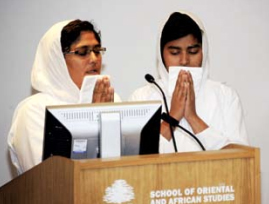
Samaṇī Pratibhaprajñā and Samaṇī Rohitprajñā (Jain Vishva Bharati University, Ladnun)
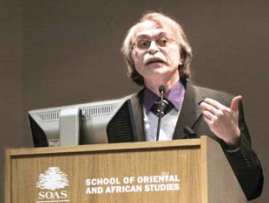
Robert Zydenbos delivered the 11th Annual Jaina Lecture.
Sin Fujinaga (Miyakonojô Kôsen) explored the use of narratives in Malayagiri's commentarial treatises on various Jaina (semi-)canonical texts and raised the interesting question as to why the erudite Jaina scholar, although evidently familiar with Prakrit, opted for quoting solely Sanskrit narratives when commenting on the Nandīsūtra. Fujinaga postulated that Malayagiri's peculiar choice of Sanskrit narratives lies in the fact that the interest in the subject discussed in the Nandīsūtra, epistemology, exceeded the boundaries of the Jaina community and reached followers of other sects.
Peter Flügel's (SOAS) rich and detailed paper critically analyzed the symbolism in Jaina narratives on the relic worship of Jinas. He pointed out that the only historical evidence for the origin of the observable practice of relic worship among Jainas today is found in the Āvaśyaka literature and early universal histories of the middle and late-canonical periods. A striking feature of these narratives, he noted, is the consistent recurrent motif of the removal and worshipping of the Jinas' relics by gods. From a strict doctrinal point of view the worship of physical remains is a contradictio in terminis. However, he argued, when the relics are made physically inaccessible for humans due to their displacement by gods into their realms, they can aptly be turned into symbols of the Jinas' exemplary lives and teachings.
These first three lectures were followed by a discussion led by Nalini Balbir (Sorbonne). Balbir suggested that for the study of Jaina narratives it would be interesting to juxtapose later textual additions or the various adaptations of Jaina narratives to discern shifts of focus and intentions of the author.
Anne E. Monius' (Harvard Divinity School) mapping out the landscapes of Hindu, Buddhist and Jaina Tamil literature, raised the fascinating question as to why in Jaina Tamil narratives in sharp contrast to their Hindu and Buddhist counterparts there is a conspicuous absence of 'localizing' the scenes in the Tamil speaking region. She dismissed as unconvincing the hypothesis that this is because Jaina Tamil authors mainly drew their characters and plots from Northern Sanskrit and Prakrit sources, and instead postulated that the consistent Northern geography in Jaina Tamil narrative might lie in the distinct Jaina attitude to conceive the path to liberation as eternal, i.e. not subject to the constraints of time and space. Seen from this perspective there is simply no need for Jaina Tamil authors to relocate the geography of their narratives to the Tamil speaking region.
Michael Willis (British Museum) revisited the inscription of King Bhoja (r. circa 1000 to 1055) on the base of the standing figure of the goddess Ambikā, which has been held in the British Museum since the 1880s. A new examination of the inscription has shown that the statue's donor was the religious superintendent of King Bhoja, named Vararuci. Willis, examining the different characters named Vararuci in medieval Indian narratives, suggested that the donor Vararuci was none other than the sage Dhanapāla.
Paul Dundas (University of Edinburgh) familiarized the audience with eleventh to twelfth-century Śvetāmbara Jaina narratives: the Saṃvegaraṃgasālā, the Dharmaratnakaraṇḍaka and the Upadeśamālā, which have hitherto been left unexplored by the academic world outside India. Pointing out the pool of information one can extract regarding the Śvetāmbara renunciant lineages, he encouraged further research into these narratives if, he pointedly added, one can manage to find a copy. With this latter remark he emphasized the urgent need to create adequate and accessible bibliographical tools for research into Jaina narratives.
The morning session was concluded with the critical questions and insights of the discussant Herman Tieken (University of Leiden).
The afternoon session began with Christine Chojnacki (University of Lyon). In an excellent presentation entitled 'Remodeling Jain Novels in Medieval Times: Means and Motivations' Chojnacki ventured into the historical how and why of epitomes written by a seemingly organized board of monks of ninth to twelfth-century Jaina novels.
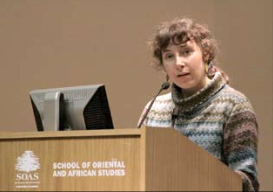
Anna Aurelia Esposito (University of Würzburg)
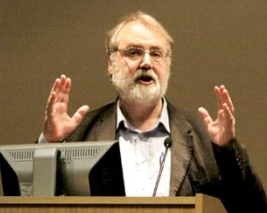
Paul Dundas (University of Edinburgh)
Naomi Appleton (Cardiff University) presented an interesting comparative study of past birth narratives in Jaina and Buddhist tradition. Focusing on how the paths to perfection for Jinas-to-be and bodhisattvas are depicted in respectively Jaina and Buddhist past birth narratives, Appleton persuasively demonstrated that although the setting of a Jaina narrative and the challenges faced by a Jina-to-be might have found high resonance in a Buddhist Jātaka story, the Jaina narrative will nevertheless always carry a distinctively Jaina stamp upon it. Two unique features of Jaina birth stories are their emphasis on the inevitability and unpredictability of karmic consequences, and the positive role of asceticism to ultimately achieve karmic disentanglement or Jinahood.
Whitney Kelting's (Northwestern University) vivid presentation dealt with Śvetāmbara pregnancy stories of the Jinamātās. Analysing the story of Mahāvīra's conception and birth in the Kalpasūtra, Kelting showed how the discourse on Triśalā's pregnancy transformed, as it were, the Jinamātā's pregnant body into an instructive body through which Jaina virtues are assessed and promulgated. She further pointed out that the famous episode of the embryo transfer, unique to the Śvetāmbara version, serves as an identity marker for the Śvetāmbara community.
Before the afternoon coffee break a brief discussion session was held during which Olle Qvarnström (University of Lund) offered his critical insights into the presentations of Christine Chojnacki, Naomi Appleton and Whitney Kelting.
The next session began with Anna Aurelia Esposito (University of Würzburg) who deepened our knowledge of Jaina narrative by bringing to light the didactic functions of dialogues in Jaina literature. It is well known that in Jaina literature the main narrative is frequently interrupted by secondary stories by means of dialogue. The result of these frequent interruptions is a multitude or web of narrative layers, making the confused reader wonder about the reasons for these interruptions. Esposito, having critically analyzed the content of inserted narrative dialogues in various Jaina stories (such as Saṅghadāsa's Vasudevahiṇḍī and Haribhadra's Samarāiccakahā), convincingly argued that the main purpose of the dialogical interruptions is to convey doctrinal elements. She further illustrated how the medium of dialogue is strategically well chosen as it invites the emotional and intellectual identification of the reader.

(From left) Professor J.C. Wright (SOAS) honoured the winners of the Centre of Jaina Studies essay prizes. Shruti Malde, MA SOAS, was awarded the SOAS Postgraduate Dissertation Prize in Jaina Studies 2011 for 'The Concept of Leśyā in Jaina Literature'. Elisabetta Marabotto accepted the SOAS Undergraduate Essay Prize in Jaina Studies 2011 for her essay entitled, 'Jain Art & Ritual: The Independent Core of Jain Religious Life'. Prizes presented by Robert Lightfoot, N.K. Sethia Foundation & IOJ London. Photos: Glenn Ratcliffe
Basile Leclère's (University of Lyon) rich paper dealt with two related, but highly understudied, topics: Jaina Medieval drama and its impact on style and structure of later narrative writings.
Richard Fynes (De Montfort University) with his lively analysis of the poems of 17th-century RājasthānīGujarātī Jaina poet Ānandghan showed the applicability of narratological categories for poetry analysis. He ended his presentation with a visual treat: a modern dance adaptation of Ānandghan's work by DMU students.
The findings of Anna Aurelia Esposito, Basile Leclère and Richard Fynes were further examined during thediscussion session led by Francesca Orsini (SOAS).
That Jainas were active participants in the literary discourse of premodern India was amply confirmed by Eva De Clercq's (University of Ghent) detailed paper. In discussing two distinct but overlapping Jaina textual categories: the (1) Dhūrtākhyānas and Dharmaparīkṣas, and (2) Jaina Purāṇas, she showed how the first category of Jaina texts focused on rejecting erroneous views expressed in popular Hindu narratives, whereas the latter category, although also aimed at removing current heretical ideas, mainly concentrated on appropriating popular Hindu narratives, offering alternative versions of 'problematic' Hindu passages.
Jonathan Geen's (University of Western Ontario) presentation 'Nārada, Non-Violence and False Avatāras in Hindu and Jaina Purāṇas' reminded the audience of the importance of studying Jaina culture and its literary production in relation to its wider Indian context. Taking as a case study the popular purāṇic character Nārada, Geen showed how the development of the character, in both Jaina and Hindu purāṇas, as a spokesman for nonviolence cannot be understood if both purāṇic traditionsare studied in isolation. Geen convincingly argued that the presence of the character in both traditions points to textual interaction and mutual influence.
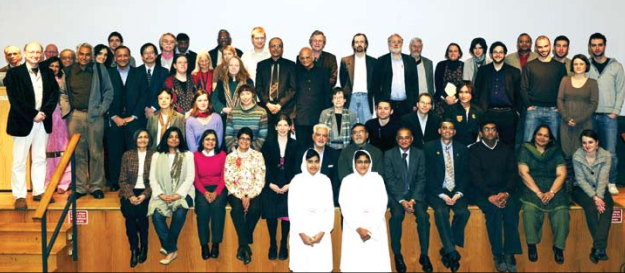
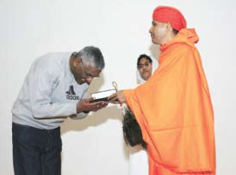
In acknowledgement for his untiring publicity work for the CoJS Dr Atul Shah receives the SOAS pen from the hands of Bhaṭṭāraka Cārukīrti from the Mūḍabidrī Maṭh.
When standing at the end of a long and intensive conference day, it is a tricky task to hold the audience's attention. However, Bradley M. Boileau (University of Ottawa) masterfully succeeded in keeping the interest of the audience alive with his original presentation on the Diwakar Chitra Katha (DCK), a 60-piece Jaina comic book series. To the great interest of many Jaina lay people in the audience, Bradley argued that the DCK series, which draws its inspiration from Hemacandra's twelfthcentury Triṣaṣṭiśalākāpuruṣacaritra, is a successful modern educational tool for conveying the major events of the lives of the Jinas, cakravartins and other Jaina personages. He further demonstrated that the comic series inevitably made different emphases due to its role, targeted audience, and most of all, its format. The intensive day-long worshop was fittingly concluded with a final discussion chaired by Renate Söhnen-Thieme (SOAS).
The 13th SOAS Jaina Studies workshop, Jaina Narratives, with its many excellent papers and lively discussions, was an enriching experience for all who attended. In bringing together scholars, students and Jaina lay people the workshop succeeded in the difficult but highly important task of creating a transparent and interactive scholarly platform where research ideas could be exchanged and discussed, and future research avenues pointed out. We are looking forward to the upcoming 14th SOAS Jaina Studies workshop Biodiversity Conservation and Animal Rights: Religious and Philosophical Perspectives.
Claire Maes studied Indology (MA) at the University of Ghent and Philosophy (MA) at Mysore University, India. With a fellowship from the Research FoundationFlanders, she is currently conducting PhD research on early Jaina and Buddhist monastic precepts. Her publication 'One Sensed Facultied Life (ekindriya jīva) in the Pāli Vinaya: A Camouflaged Debate between Early Buddhists and Jains' will be published in the forthcoming issue of Bulletin D'Études Indiennes.
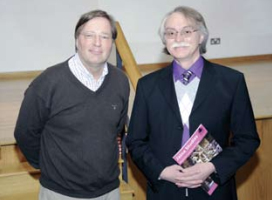
Olle Qvarnström and Robert J. Zydenbos
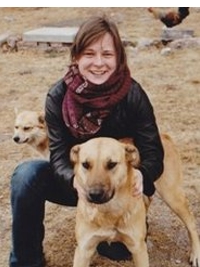 Claire Maes
Claire Maes